Survival to oral cancer. A study of clinical risk markers with independent prognostic value
Abstract
The aims of this study have been to describe survival to oral cancer and to identify clinical variables with independent influence on its prognosis before treatment. METHODS: 94 oral cancer patients treated during 1991-99 entered the study. The variables considered were: age, sex, location of the lesion, clinical presentation, symptoms, TNM classification, months elapsed since treatment and ploidy pattern. A descriptive study of the data was performed, along with a survival analysis using Kaplan-Meier curves (log rank test for comparison among curves) and single and multivariate Cox regression. RESULTS: Multivariate analysis recognized a prognostic value for the age of the patient (OR = 1.06; CI95%: 1.02-1.09) and also for tumour size. Tumour stage resulted also selected, but its predictive value was lower than size's, so it was excluded from the predictive model. No statistically significant differences in terms of survival were identified on the rest of variables considered in the study. CONCLUSIONS: This study suggests the need for considering age and tumour size as the most relevant clinical variables for predicting survival to oral cancer at the time of diagnosis.
Downloads
Published
Issue
Section
License
I hereby certify that the authors of the above manuscript have all:
1. Conceived, planned, and performed the work leading to the report, or interpreted the evidence presented, or both;
2. Written the report or reviewed successive versions and shared in their revisions; and
3. Approved the final version.
Further, I certify that:
1. This work has not been published elsewhere and is not under revision in another journal;
2. Humane procedures have been followed in the treatment of experimental animals (if applicable);
3. Investigations in humans was done in accordance with the ethical standards of the responsible committee on human experimentation or with the Helsinki Declaration (if applicable).
4. This paper has been carefully read by a native English speaker who is familiar with the field of work (this applies to authors who are not fluent in English); and
5. The copyright of the article is transferred from the authors to the Bulletin du Groupement International pour la Recherche Scientifique en Stomatologie et Odontologie upon acceptance of the manuscript.



